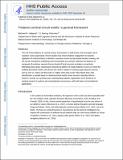Thalamocortical Circuit Motifs: A General Framework
Author(s)
Halassa, Michael M; Sherman, S Murray
DownloadAccepted version (520.7Kb)
Publisher with Creative Commons License
Publisher with Creative Commons License
Creative Commons Attribution
Terms of use
Metadata
Show full item recordAbstract
The role of the thalamus in cortical sensory transmission is well known, but its broader role in cognition is less appreciated. Recent studies have shown thalamic engagement in dynamic regulation of cortical activity in attention, executive control, and perceptual decision-making, but the circuit mechanisms underlying such functionality are unknown. Because the thalamus is composed of excitatory neurons that are devoid of local recurrent excitatory connectivity, delineating long-range, input-output connectivity patterns of single thalamic neurons is critical for building functional models. We discuss this need in relation to existing organizational schemes such as core versus matrix and first-order versus higher-order relay nuclei. We propose that a new classification is needed based on thalamocortical motifs, where structure naturally informs function. Overall, our synthesis puts understanding thalamic organization at the forefront of existing research in systems and computational neuroscience, with both basic and translational applications. Halassa and Sherman highlight the role of the thalamus in cortical function and the lack of knowledge surrounding thalamocortical connectivity at single-cell resolution. They propose thalamocortical motifs as units of organization with potential to inform cognitively relevant functional models.
Date issued
2019Department
Massachusetts Institute of Technology. Department of Brain and Cognitive Sciences; McGovern Institute for Brain Research at MITJournal
Neuron
Publisher
Elsevier BV
Citation
Halassa, Michael M and Sherman, S Murray. 2019. "Thalamocortical Circuit Motifs: A General Framework." Neuron, 103 (5).
Version: Author's final manuscript